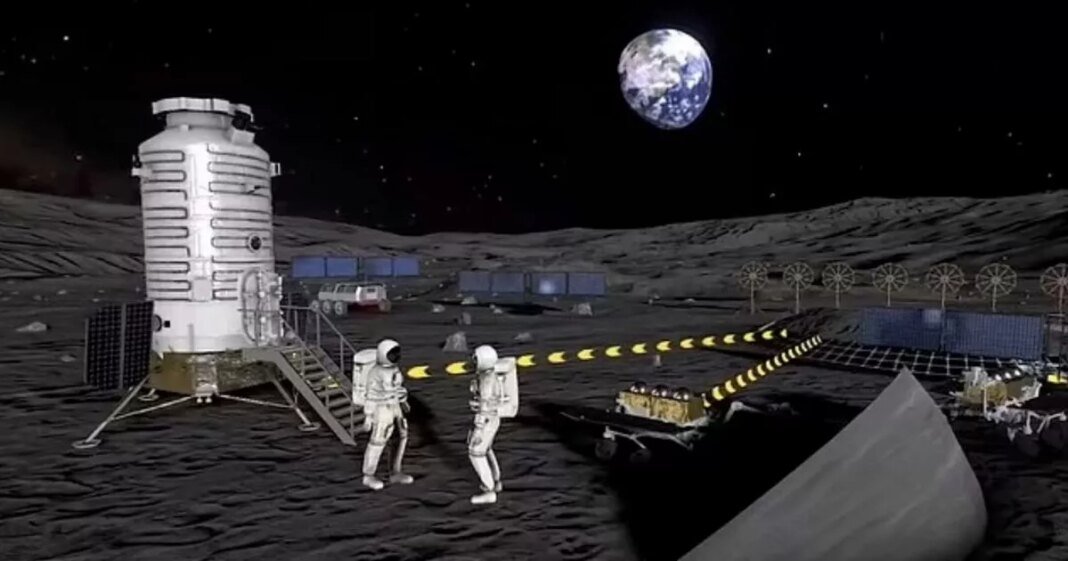China has unveiled a bombshell new plan to join forces with Russia and build a nuclear plant on the moon which will power a research station. It comes as the East Asian country today launched three astronauts into space to replace the crew on its Tiangong space station.
In a bid to become a major space power – and land astronauts on the moon by 2030 – China‘s new Chang’e-8 mission will aim to test resource technologies at the moon‘s south pole and build a lunar base, specifically the International Lunar Research Station (ILRS). The mission, scheduled to launch around 2028, is also set to explore 3D printing with lunar soil and the use of a robotic arm and potentially a humanoid robot sent up to the moon to explore its surface. Chang’e-8’s Chief Engineer Pei Zhaoyu revealed in a presentation in Shanghai on Wednesday that the lunar base‘s energy supply could depend on large-scale solar arrays, as well as pipelines and cables for heating and electricity built on the moon’s surface.
Lat year, Russia’s space agency Roscosmos said it planned to build a nuclear reactor on the moon’s surface with the China National Space Administration (CNSA) by 2035 to power the ILRS. Although it is yet to be formally announced, the inclusion of the nuclear power unit at the conference, held for officials from the 17 countries and international organisations that make up the ILRS, Beijing appears to support the idea.
Wu Weiren, chief designer of China’s lunar exploration program, told Reuters: “An important question for the ILRS is power supply, and in this Russia has a natural advantage, when it comes to nuclear power plants, especially sending them into space, it leads the world, it is ahead of the United States.” After little progress on talks over a space-based reactor in the past, “I hope this time both countries can send a nuclear reactor to the moon,” Wu said.
China’s timeline to build an outpost on the moon’s south pole coincides with NASA’s Artemis programme, which aims to put US astronauts back on the moon in December 2025. Wu said last year that a “basic model” of the lunar research station, centred around the moon’s south pole, would be built by 2035.
Going forward, China will create the “555 Project,” inviting 50 countries, 500 international scientific research institutions, and 5,000 overseas researchers to join the ILRS. Researchers from Roscosmos also shared more exciting details about plans to look for mineral and water resources at the conference in Shanghai, including possibly using lunar material as fuel.
The ILRS preceded Russia’s invasion of Ukraine in 2022 but incentives for cooperation between Roscosmos and CNSA have increased since the outbreak of the war, according to Chinese analysts.
With China’s rapid technological advances and lunar achievements, and as Western sanctions prevent Roscosmos from many imports of space technology and equipment, China can now “alleviate the pressure” on Russia and help it “achieve new breakthroughs in satellite launches, lunar exploration, and space stations,” Liu Ying, a researcher at the Chinese foreign ministry’s diplomatic academy, wrote in a journal article last year.
At Reach and across our entities we and our partners use information collected through cookies and other identifiers from your device to improve experience on our site, analyse how it is used and to show personalised advertising. You can opt out of the sale or sharing of your data, at any time clicking the “Do Not Sell or Share my Data” button at the bottom of the webpage. Please note that your preferences are browser specific. Use of our website and any of our services represents your acceptance of the use of cookies and consent to the practices described in our Privacy Notice and Cookie Notice.



